Investigation of Carbon-Dioxide-Emissions from Underutilized Grassland between 2019 and 2020
Abstract
1. Introduction
- -
- How does atmospheric natural precipitation affect carbon dioxide emissions in grassland under different treatments?
2. Materials and Methods
- Unused/abandonment grassland: since 2009, the area has been unused (designation: A/Z);
- Mulch treatment: since 3 May 2009 (Desigination: A/M);
- Mowing treatment: Mowing only once a year, in the third decade of May, and removal of phytomass (designation: A/K);
- Grassland management: Mowing in the third decade of May, haying, and, in August, sheep grazing on hay (designation: A/R);
3. Results
4. Discussion
5. Conclusions
Author Contributions
Funding
Data Availability Statement
Conflicts of Interest
References
- Campbell, B.; Frost, P.; Byron, N. Miombo woodlands and their use: Overview and key issues. In The Miombo in Transition: Woodlands and Welfare in Africa; Campbell, B., Ed.; Center for International Forestry Research: Bogor, Indonesia, 1996; pp. 1–10. [Google Scholar]
- White, P.R.; Murray, S.; Rohweder, M. Pylot Analysis of Global Ecosystems. Grassland Ecosystems; World Resources Institute: Washington, DC, USA, 2000; pp. 1–89. [Google Scholar]
- Hunt, J.E.; Kelliher, F.M.; McSeveny, T.M.; Byers, J.N. Evaporation and carbon dioxide exchange between the atmosphere and a tussock grassland during a summer drought. Agric. For. Meteorol. 2002, 111, 65–82. [Google Scholar] [CrossRef]
- Heimsch, L.; Lohila, A.; Tuivinen, J.-P.; Vekuri, H.; Heinonsalo, J.; Nevalainen, O.; Korkiakoski, M.; Liski, J.; Laurila, T.; Kulmala, L. Carbon dioxide fluxes and carbon balance of an agricultural grassland in southern Finland. Biogeosciences 2021, 18, 3467–3483. [Google Scholar] [CrossRef]
- Keesstra, S.D.; Bouma, J.; Wallinga, J.; Tittonell, P.; Smith, P.; Cerdà, A.; Montanarella, L.; Quinton, J.N.; Pachepsky, Y.; van der Putten, W.H.; et al. The Significance of Soils and Soil Science towards Realization of the United Nations Sustainable Development Goals. Soil 2016, 2, 111–128. [Google Scholar] [CrossRef]
- Feng, J.; Wang, J.; Ding, L.; Yao, P.; Qiao, M.; Yao, S. Meta-Analyses of the Effects of Major Global Change Drivers on Soil Respiration across China. Atmos. Environ. 2017, 150, 181–186. [Google Scholar] [CrossRef]
- Singh, M.; Sarkar, B.; Sarkar, S.; Churchman, J.; Bolan, N.; Mandal, S.; Menon, M.; Purakayastha, T.J.; Beerling, D.J. Stabilization of soil organic carbon as influenced by clay mineralogy. Adv. Agron. 2018, 148, 33–84. [Google Scholar] [CrossRef]
- Yang, Y.; Tilman, D.; Furey, G.; Lehman, C. Soil carbon sequestration accelerated by restoration of grassland biodiversity. Nat. Commun. 2019, 10, 718. [Google Scholar] [CrossRef]
- Minasny, B.; Malone, B.P.; McBratney, A.B.; Angers, D.A.; Arrouays, D.; Chambers, A.; Chaplot, V.; Chen, Z.-S.; Cheng, K.; Das, B.S.; et al. Soil carbon 4 per mille. Geoderma 2017, 292, 59–86. [Google Scholar] [CrossRef]
- Szente, K.; Nagy, Z.; Tuba, Z. Enhanced water use efficiency in dry loess grassland species grown at elevated air CO2 concentration. Photosynthetica 1998, 35, 637–640. [Google Scholar] [CrossRef]
- Stefler, J.; Nagy, G.; Vinczeffy, I. Különböző adottságú gyepek hasznosíthatósága húsmarhatartással. Állattenyésztés Takarmányozás 2000, 49, 495–496. [Google Scholar]
- Magyar, I.E. Gyógynövényes Gyep Telepíthetősége, Gyepgazdálkodási Módszerek Növényállományra Gyakorolt Hatásának Értékelése. Ph.D. Thesis, Szent István Egyetem, Gödöllő, Hungary, 2009. [Google Scholar]
- Czóbel, S.; Szirmai, O.; Németh, Z.; Gyuricza, C.; Házi, J.; Tóth, A.; Schellenberger, J.; Vasa, L.; Penksza, K. Short-term effects of grazing exclusion on net ecosystem CO2 exchange and net primary production in a Pannonian sandy grassland. Not. Bot. Horti Agrobot. Cluj-Napoca 2012, 40, 67–72. [Google Scholar] [CrossRef][Green Version]
- Dhital, D.; Prajapati, S.; Maharjan, S.R.; Koizumi, H. Soil Carbon Dioxide Emission: Soil Respiration Measurement in Temperate Grassland, Nepal. J. Environ. Prot. 2019, 10, 289–314. [Google Scholar] [CrossRef][Green Version]
- Lorenz, K.; Lal, R. Carbon Sequestration in Agricultural Ecosystems; Springer: Cham, Switzerland, 2018; pp. 39–136. [Google Scholar] [CrossRef]
- Harrison, P.A.; Dunford, R.W.; Holman, I.P.; Cojocaru, G.; Madsen, M.S.; Chen, P.-Y.; Pedde, S.; Sandars, D. Differences between low-end and high-end climate change impacts in Europe across multiple sectors. Reg. Environ. Chang. 2019, 19, 695–709. [Google Scholar] [CrossRef]
- Bastos, A.; Ciais, P.; Friedlingstein, P.; Sitch, S.; Pongratz, J.; Fan, L.; Wigneron, J.; Weber, U.; Reichstein, M.; Fu, Z.; et al. Direct and seasonal legacy effects of the 2018 heat wave and drought on European ecosystem productivity. Sci. Adv. 2020, 6, eaba2724. [Google Scholar] [CrossRef] [PubMed]
- Tramontana, G.; Jung, M.; Schwalm, C.R.; Ichii, K.; Camps-Valls, G.; Ráduly, B.; Reichstein, M.; Altaf Arain, M.; Cescatti, A.; Kiely, G.; et al. Predicting carbon dioxide and energy fluxes across global FLUXNET sites with regression algorithms. Biogeosciences 2016, 13, 4291–4313. [Google Scholar] [CrossRef]
- Balogh, J.; Fóti, S.; Pintér, K.; Cserhalmi, D.; Papp, M.; Koncz, P.; Nagy, Z. A talajok CO2-kibocsátásának jelentősége hazai gyepek szénforgalmában. Kitaibelia 2012, 17, 9. [Google Scholar]
- Kovács, G.; Szőllősi, N. A talaj CO2-emissziójának mérésére szolgáló eszközök mérőhelyspecifikus fejlesztése. Agrártudományi Közlemények 2008, 30, 53–58. [Google Scholar]
- Zsembeli, J.; Szűcs, L.; Tuba, G.; Czimbalmos, R. Nedvességtakarékos talajművelési rendszer fejlesztése Karcagon. In Környezetkímélő Talajművelési Rendszerek Magyarországon; Madarász, B., Ed.; MTA CSFK FTI: Budapest, Magyarorság, 2015; pp. 122–133. [Google Scholar]
- Birkás, M. Földművelés és Földhasználat; Mezőgazda Lap-és Könyvkiadó: Budapest, Magyarország, 2017; pp. 1–482. [Google Scholar]
- Kovács, G.; Tuba, G.; Czimbalmos, R.; Csízi, I. Különböző komposztadagok hatása az extenzív gyep talajának néhány tulajdonságára. Gyepgazdálkodási Közlemények 2013, 9–14. [Google Scholar] [CrossRef]
- Oertel, C.; Matschullatt, J.; Zurba, K.; Zimmermann, F.; Erasmi, S. Greenhouse gas emissions from soils. A review. Geochemistry 2016, 76, 327–352. [Google Scholar] [CrossRef]
- Hénault, C.; Bourennane, H.; Ayzac, A. Management of pH promotes notrous oxide reduction and thus mitigates soil emissions of this greenhouse gas. Sci. Rep. 2019, 9, 20182. [Google Scholar] [CrossRef]
- Wu, G.; MinChen, X.; Ling, J.; Li, F.; Li, F.Y.; Peixoto, L.; When, Y.; Zhou, S.L. Effect of soil warming and increased precipitation on greenhouse gas fluxes in spring maize seasons in the North China Plain. Sci. Total Environ. 2020, 734, 139269. [Google Scholar] [CrossRef]
- Szemán, L. Gyepgazdálkodási Módszertan; Szent István Egyetem: Gödöllő, Magyarország, 2006; pp. 1–103. [Google Scholar]
- Szemán, L. Gyepgazdálkodási Ismeretek; Szent István Egyetem: Gödöllő, Magyarország, 2006; pp. 1–89. [Google Scholar]
- Szemán, L. Gyep és Tájgazdálkodás; Szent István Egyetem: Gödöllő, Magyarország, 2008; pp. 1–94. [Google Scholar]
- Enyedi, Z.M.; Ruprecht, E.; Deák, M. Long-term effects of the abandonment of grazing on steppe-like grasslands. Appl. Veg. Sci. 2008, 11, 53–60. [Google Scholar] [CrossRef]
- Mitchley, J.; Xofis, P. Landscape structure and management regime as indicators of calcareous grassland habitat condition and species diversity. J. Nat. Conserv. 2005, 13, 171–183. [Google Scholar] [CrossRef]
- Tasi, J.; Bajnok, M.; Halász, A.; Szabó, F.; Harkányiné Székely, Z.; Láng, V. Magyarországi komplex gyepgazdálkodási adatbázis létrehozásának első lépései és eredményei. Gyepgazdálkodási Közlemények 2014, 57–64. Available online: https://ojs.lib.unideb.hu/gygk/article/view/9770/8699 (accessed on 6 February 2022).
- Vincze, J. Az Észak-Magyarországi Régió Állattenyésztésének Fejlesztési Lehetőségei és Irányai. Ph.D. Thesis, Nyugat-Magyarországi Egyetem, Sopron, Hungary, 2008. [Google Scholar]
- Wiliems, J.H.; Bik, L.P.M. Restoration of high species density in calcareous grassland: The role of seed rain and soil seed bank. Appl. Seed Ecol. 1998, 1, 91–100. [Google Scholar] [CrossRef]
- Török, P.; Arany, I.; Prommer, M.; Valkó, O.; Balogh, A.; Vida, E.; Tóthmérész, B.; Matus, G. Újrakezdett kezelés hatása fokozottan védett kékperjés láprét fitomasszájára, faj-és virággazdagságára. Természetvédelmi Közlemények 2007, 13, 187–198. [Google Scholar]
- Kahmen, S.; Poschlod, P.; Schreiber, K.-F. Conservation management of calcareous grasslands. Changes in plant species composition and response of functional traits during 25 years. Biol. Conserv. 2002, 104, 319–328. [Google Scholar] [CrossRef]
- Isselstein, J.; Jeangros, B.; Pavlů, V. Agronomic aspects of biodiversity targeted management of temperate grasslands in Europe—A review. Agric. Res. 2005, 3, 139–151. [Google Scholar]
- Penksza, K.; Fehér, Á.; Saláta, D.; Pápay, G.S.; Falusi, E.; Kerényi-Nagy, V.; Szabó, G.; Wichmann, B.; Szemethy, L.; Katona, K. Gyepregeneráció és vadhatás vizsgálata cserjeirtás után parádóhutai (Mátra) mintaterületen. Gyepgazdálkodási Közlemények 2016, 14, 31–41. [Google Scholar]
- Pápay, G. Cserjeirtás után magára hagyott, legeltetett és kaszált gyepterületek vegetációjának összehasonlító elemzése parádóhutai (Mátra) mintaterületen. Gyepgazdálkodási Közlemények 2016, 14, 37–48. [Google Scholar]
- Barcsák, Z.; Baskay-Tóth, B.; Prieger, K. Gyeptermesztés és Hasznosítás; Mezőgazdasági Kiadó: Budapest, Magyarország, 1978; pp. 1–339. [Google Scholar]
- Szabó, G.; Zimmermann, Z.; Szentes, S.; Sutyinszki, Z.; Penksza, K. Természetvédelmi és gyepgazdálkodási vizsgálatok a Dinnyési-Fertő gyepeiben. Gyepgazdálkodási Közlemények 2010, 8, 31–38. [Google Scholar]
- Bajor, Z.; Zimmermann, Z.; Szabó, G.; Fehér, Z.; Járdi, I.; Lampert, R.; Kerény-Nagy, V.; Penksza, P.L.; Szabó, Z.; Székely, Z.; et al. Effect of conservation management practices on sand grassland vegetation in Budapest, Hungary. Appl. Ecol. Environ. Res. 2016, 14, 233–247. [Google Scholar] [CrossRef]
- Hansson, M.; Fogelfors, H. Management of semi-natural grassland; results from a 15-year old experiment in southern Sweden. J. Veg. Sci. 2000, 11, 31–38. [Google Scholar] [CrossRef]
- Kozák, L. Élőhely-Kezelés; Debreceni Egyetem, Agrár-és Gazdálkodástudományok Centruma: Debrecen, Magyarország, 2011; pp. 1–86. [Google Scholar]
- Szentes, S.; Sutyinszki, Z.; Zimmermann, Z.; Szabó, G.; Járdi, I.; Házi, J.; Penksza, K.; Bartha, S. A fenyérfű (Bothriochloa ischaemum L. Keng 1936.) gyep béta-diverzitására gyakorolt hatásainak vizsgálata és értékelése mikrocönológiai módszerekkel. Tájökológiai Lapok 2011, 9, 463–475. [Google Scholar]
- Szentes, S.; Sutyinszki, Z.; Szabó, G.; Zimmermann, Z.; Házi, J.; Wichmann, B.; Hufnágel, L.; Penksza, K.; Bartha, S. Grazed Pannonian grassland beta-diversity changes due to C4 yellow bluestem. Cent. Eur. J. Biol. 2012, 7, 1055–1065. [Google Scholar] [CrossRef]
- Perevolotsky, A.; Seligman, N.G. Role of grazing in Mediterranean rangeland ecosystems. Bioscience 1998, 48, 1007–1017. [Google Scholar] [CrossRef]
- Bakker, J.P.; Berendse, F. Constraints in the restoration of ecological diversity in grassland and heathland communities. Trends Ecol. Evol. 1999, 14, 63–68. [Google Scholar] [CrossRef]
- Ryser, P.; Langenauer, R.; Gigon, A. Species richness and vegetation structure in a limestone grassland after 15 year management with six biomass removal regimes. Folia Geobot. Phytotaxon. 1995, 30, 157–167. [Google Scholar] [CrossRef]
- Buermann, W.; Forkel, M.; O’Sullivan, M.; Sitch, S.; Friedlingstein, P.; Haverd, V.; Jain, A.K.; Kato, E.; Kautz, M.; Lienert, S.; et al. Widespread seasonal compensation effects of spring warming on northern plant productivity. Nature 2018, 562, 110–114. [Google Scholar] [CrossRef]
- Brockway, D.G.; Gatewood, R.G.; Paris, R.B. Restoring fire as an ecological process in shortgrass prairie ecosystems: Initial effects of prescribed burning during the dormant and growing seasons. J. Environ. Manag. 2006, 65, 135–162. [Google Scholar] [CrossRef]
- Ónodi, G.; Kertész, M.; Botta-Dukát, Z.; Altbäcker, V. Grazing Effects on Vegetation Composition and on the Spread of Fire on Open Sand Grasslands. Arid Land Res. Manag. 2008, 22, 273–285. [Google Scholar] [CrossRef]
- Varga, K.; Csízi, I.; Monori, I.; Valkó, O. Threats and challenges related to grazing paddocks: Recovery of extremely overgrazed grassland after grazing exclusion. Arid Land Res. Manag. 2021, 35, 346–357. [Google Scholar] [CrossRef]
- Vinczeffy, I. Legelő-és Gyepgazdálkodás; Mezőgazda Kiadó: Budapest, Magyarország, 1993; pp. 1–400. [Google Scholar]
- Hortobágyi, T.; Simon, T. Növényföldrajz, Társulástan és Ökológia; Nemzeti Tankönyvkiadó: Budapest, Magyarország, 2000; pp. 1–538. [Google Scholar]
- Sefferová Stanová, V.; Janák, M.; Ripka, J. Management of Natura 2000 Habitats. 1530*Pannonic Salt Steppes and Salt Marshes; European Commission: Brussels, Belgium, 2008; pp. 1–26. [Google Scholar]
- Kovács, G. Mezőgazdasági Hasznosítású Talajok Széndioxid-Emissziójának Vizsgálata Karcag Térségében. Ph.D. Thesis, Debreceni Egyetem, Debrecen, Hungary, 2014. [Google Scholar]
- Rustad, L.E.; Campbell, J.L.; Marion, G.M.; Norby, R.J.; Mitchell, M.J.; Hartley, A.E.; Gurevitch, J. A meta-analysis of the response of soil respiration, net nitrogen mineralization, and aboveground plant growth to experimental ecosystem warming. Oecologia 2001, 126, 543–562. [Google Scholar] [CrossRef] [PubMed]
- Harper, C.W.; Blair, J.M.; Fay, P.A.; Knapp, A.K.; Carlisle, J.D. Increased rainfall variability and reduced rainfall amount decreases soil CO2 efflux in a grassland ecosystem. Glob. Chang. Biol. 2015, 11, 322–334. [Google Scholar] [CrossRef]
- Wan, S.; Luo, Y. Substrate regulation of soil respiration in a tallgrass prairie: Results of a clipping and shading experiment. Glob. Biogeochem. Cycles 2003, 17, 1054. [Google Scholar] [CrossRef]
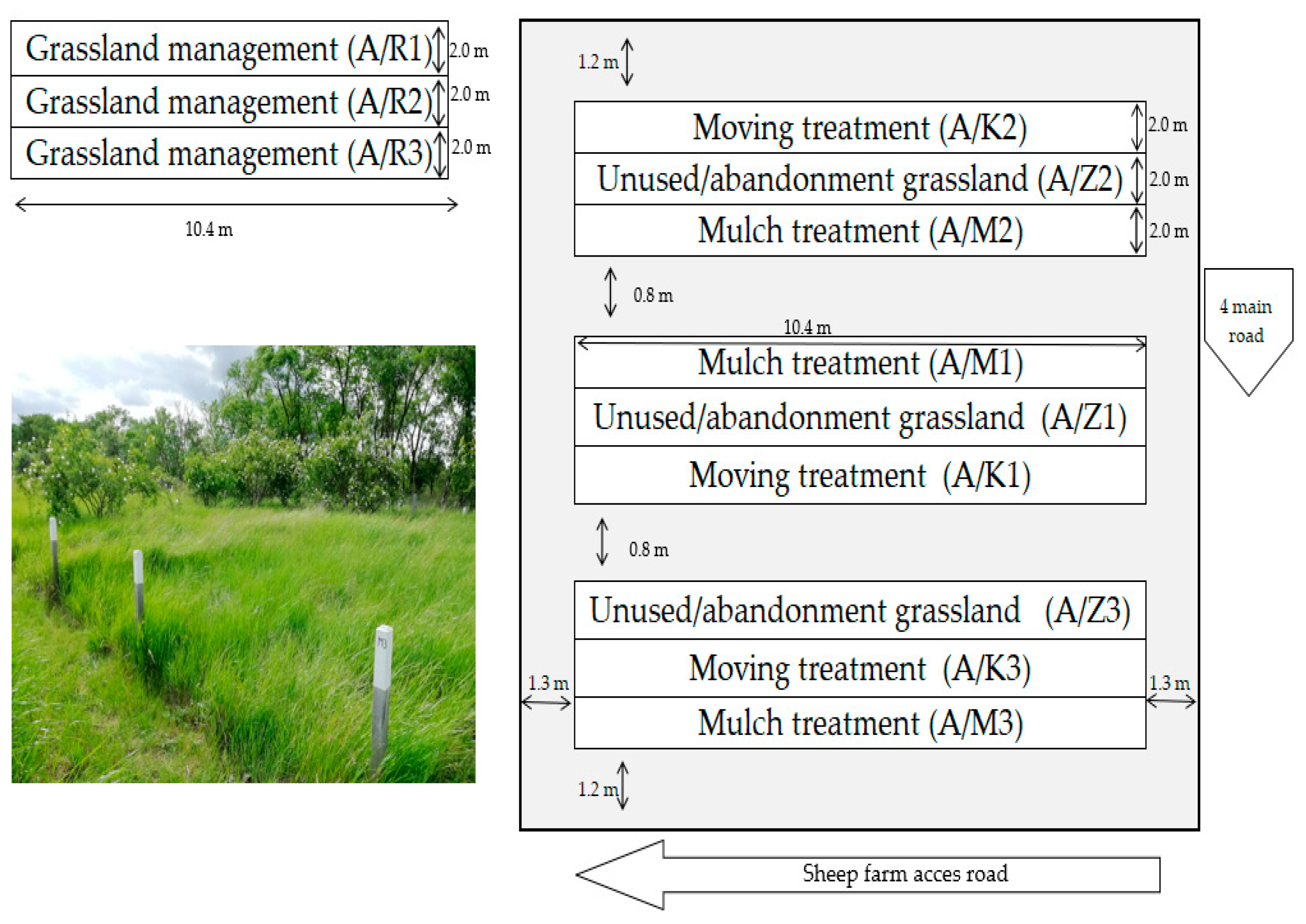
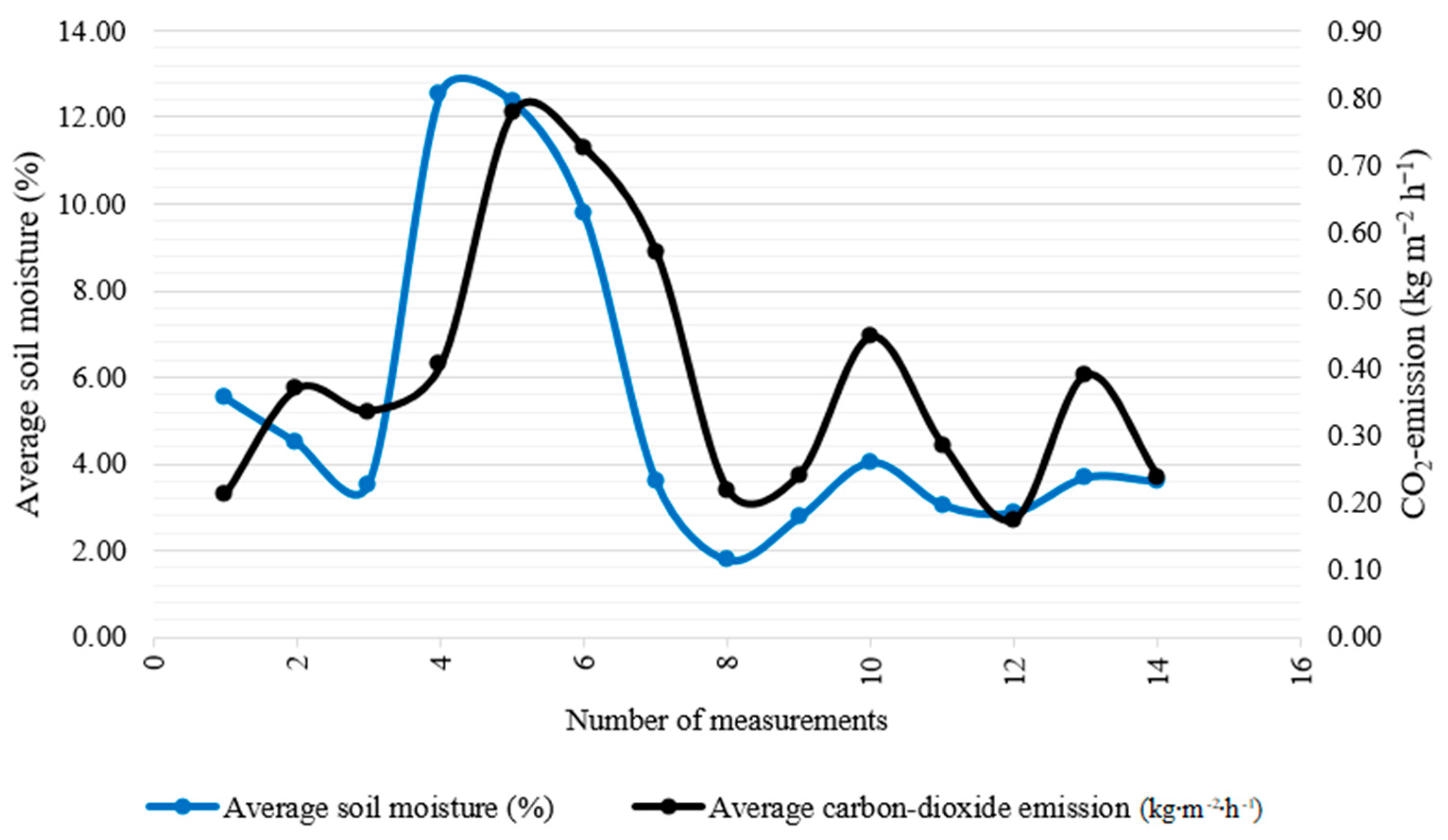

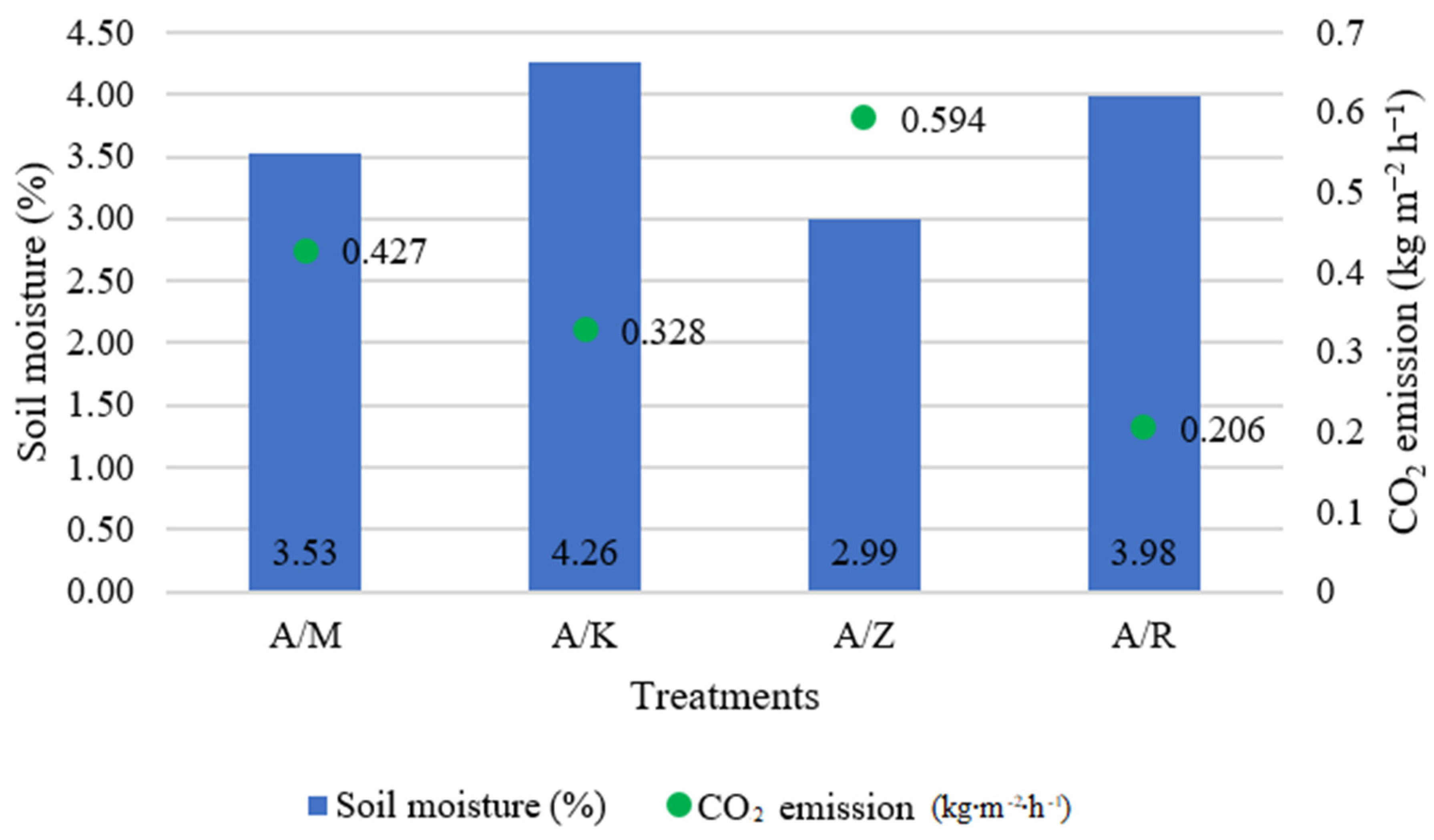
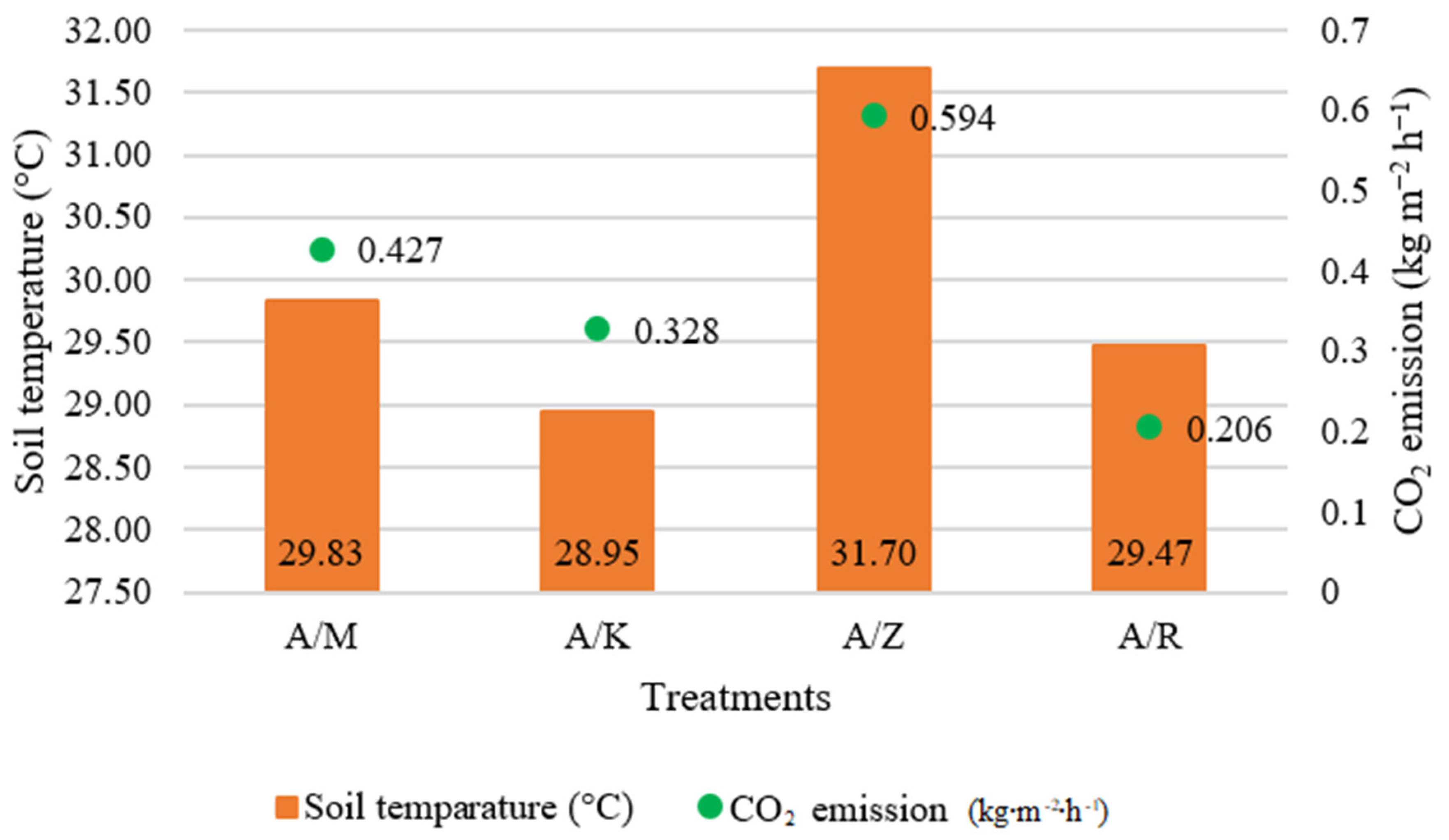


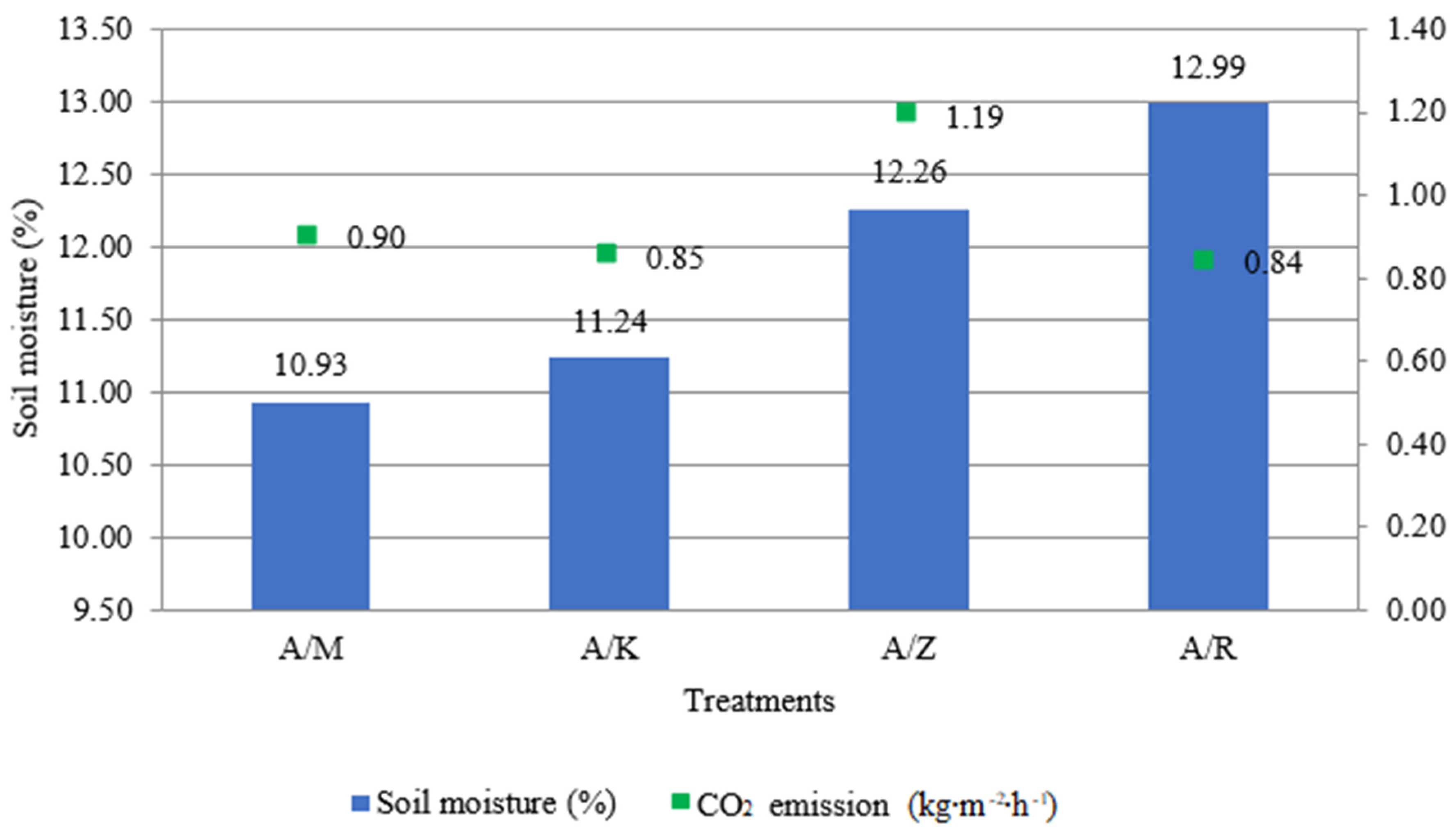
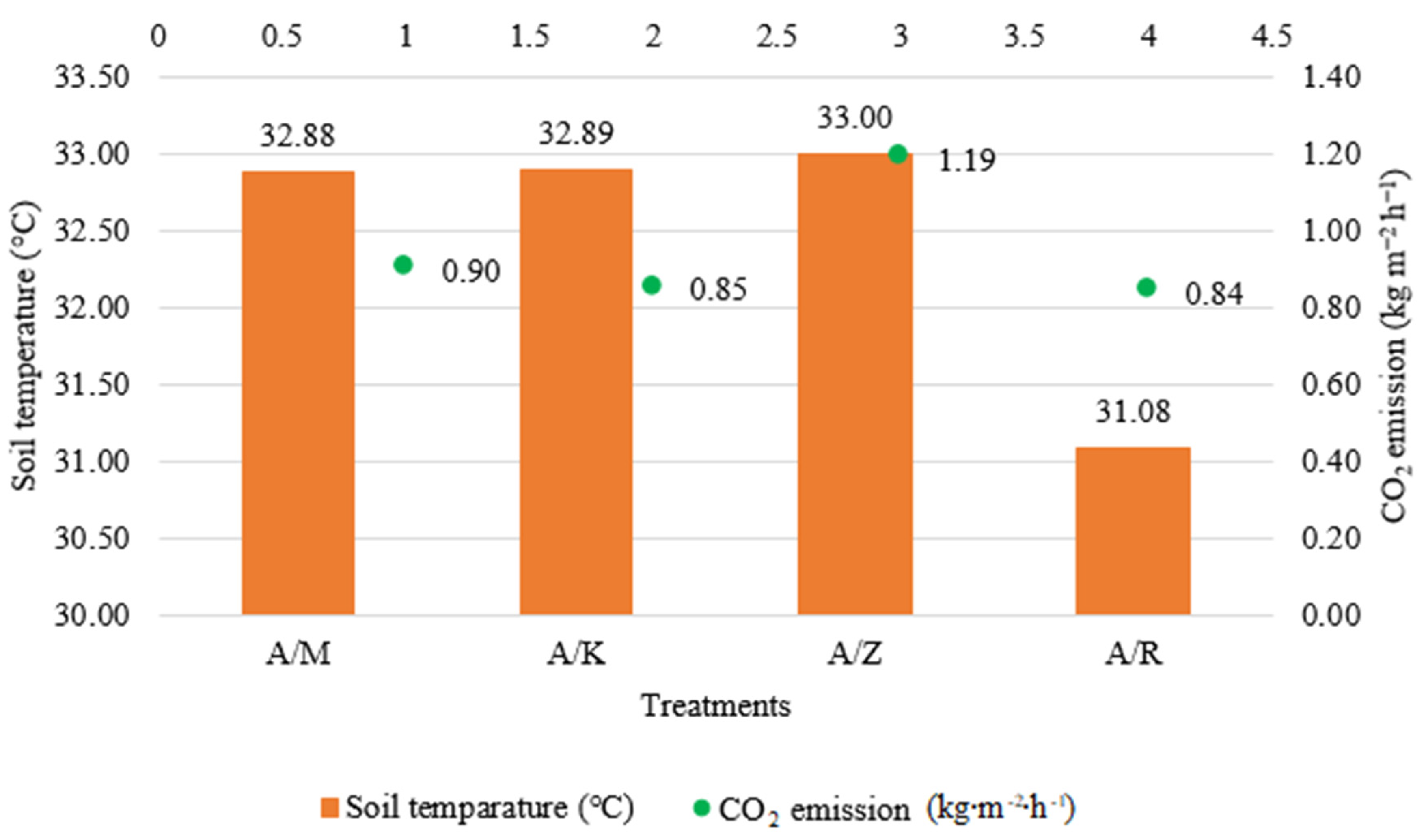
| Month | Average Temperature (°C) | Monthly Rainfall (mm) | ||
|---|---|---|---|---|
| 2019 | 2020 | 2019 | 2020 | |
| January | 2.20 | −1.00 | −1.30 | 19.80 |
| February | 0.20 | 3.70 | 4.70 | 40.20 |
| March | 3.20 | 9.00 | 6.60 | 34.40 |
| April | 16.10 | 12.90 | 11.50 | 9.80 |
| May | 19.80 | 14.60 | 14.50 | 17.80 |
| June | 21.20 | 23.10 | 20.30 | 118.40 |
| July | 22.50 | 21.80 | 21.50 | 139.30 |
| August | 24.00 | 23.80 | 23.00 | 73.30 |
| September | 18.30 | 17.20 | 18.40 | 31.70 |
| October | 13.70 | 12.90 | 12.10 | 111.20 |
| November | 7.10 | 9.10 | 5.00 | 13.80 |
| December | 0.80 | 3.10 | 3.80 | 38.80 |
| Annual | 12.50 | 13.30 | 11.70 | 648.50 |
| Month, Year | Monthly Mean Temperature (°C) | Monthly Precipitation Sum (mm) | Climate Index (mm/°C) | Categories of Climate Index |
|---|---|---|---|---|
| January, 2019 | −1.0 | 31.2 | −1.006 | - |
| February, 2019 | 3.7 | 6.2 | 0.06 | desert |
| March, 2019 | 9.0 | 8.8 | 0.032 | desert |
| April, 2019 | 12.9 | 47.3 | 0.122 | dry |
| May, 2019 | 14.6 | 116.7 | 0.258 | slighty rainy |
| June, 2019 | 23.1 | 65.5 | 0.095 | arid |
| July, 2019 | 21.8 | 59.5 | 0.088 | arid |
| August, 2019 | 23.8 | 14.6 | 0.02 | desert |
| September, 2019 | 17.2 | 40.6 | 0.079 | semi-desert |
| October, 2019 | 12.9 | 8.4 | 0.021 | desert |
| November, 2019 | 9.1 | 72.2 | 0.264 | slighty rainy |
| December, 2019 | 3.1 | 34.1 | 0.355 | very rainy |
| January, 2020 | −1.3 | 19.8 | −0.491 | - |
| February, 2020 | 4.7 | 40.2 | 0.295 | rainy |
| March, 2020 | 6.6 | 34.4 | 0.168 | medium |
| April, 2020 | 11.5 | 9.8 | 0.028 | desert |
| May, 2020 | 14.5 | 17.8 | 0.04 | desert |
| June, 2020 | 20.3 | 118.4 | 0.194 | above |
| July, 2020 | 21.5 | 139.3 | 0.209 | above |
| August, 2020 | 23.0 | 73.3 | 0.103 | arid |
| September, 2020 | 18.4 | 31.7 | 0.057 | desert |
| October, 2020 | 12.1 | 111.2 | 0.296 | rainy |
| November, 2020 | 5.0 | 13.8 | 0.092 | arid |
| December, 2020 | 3.8 | 38.8 | 0.329 | very rainy |
Publisher’s Note: MDPI stays neutral with regard to jurisdictional claims in published maps and institutional affiliations. |
© 2022 by the authors. Licensee MDPI, Basel, Switzerland. This article is an open access article distributed under the terms and conditions of the Creative Commons Attribution (CC BY) license (https://creativecommons.org/licenses/by/4.0/).
Share and Cite
Varga, K.; Halász, A.; Kovács, G.P.; Csízi, I. Investigation of Carbon-Dioxide-Emissions from Underutilized Grassland between 2019 and 2020. Agronomy 2022, 12, 931. https://doi.org/10.3390/agronomy12040931
Varga K, Halász A, Kovács GP, Csízi I. Investigation of Carbon-Dioxide-Emissions from Underutilized Grassland between 2019 and 2020. Agronomy. 2022; 12(4):931. https://doi.org/10.3390/agronomy12040931
Chicago/Turabian StyleVarga, Krisztina, András Halász, Gergő Péter Kovács, and István Csízi. 2022. "Investigation of Carbon-Dioxide-Emissions from Underutilized Grassland between 2019 and 2020" Agronomy 12, no. 4: 931. https://doi.org/10.3390/agronomy12040931
APA StyleVarga, K., Halász, A., Kovács, G. P., & Csízi, I. (2022). Investigation of Carbon-Dioxide-Emissions from Underutilized Grassland between 2019 and 2020. Agronomy, 12(4), 931. https://doi.org/10.3390/agronomy12040931






